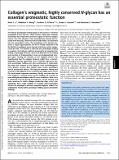| dc.contributor.author | Li, Rasia C | |
| dc.contributor.author | Wong, Madeline Y | |
| dc.contributor.author | DiChiara, Andrew S | |
| dc.contributor.author | Hosseini, Azade S | |
| dc.contributor.author | Shoulders, Matthew D | |
| dc.date.accessioned | 2022-03-18T18:53:16Z | |
| dc.date.available | 2022-03-18T18:53:16Z | |
| dc.date.issued | 2021 | |
| dc.identifier.uri | https://hdl.handle.net/1721.1/141308 | |
| dc.description.abstract | © 2021 National Academy of Sciences. All rights reserved. Intracellular procollagen folding begins at the protein’s C-terminal propeptide (C-Pro) domain, which initiates triple-helix assembly and defines the composition and chain register of fibrillar collagen trimers. The C-Pro domain is later proteolytically cleaved and excreted from the body, while the mature triple helix is incorporated into the extracellular matrix. The procollagen C-Pro domain possesses a single N-glycosylation site that is widely conserved in all the fibrillar procollagens across humans and diverse other species. Given that the C-Pro domain is removed once procollagen folding is complete, the N-glycan might be presumed to be important for folding. Surprisingly, however, there is no difference in the folding and secretion of N-glycosylated versus non-N-glycosylated collagen type-I, leaving the function of the N-glycan unclear. We hypothesized that the collagen N-glycan might have a context-dependent function, specifically, that it could be required to promote procollagen folding only when proteostasis is challenged. We show that removal of the N-glycan from misfolding-prone C-Pro domain variants does indeed cause serious procollagen and ER proteostasis defects. The N-glycan promotes folding and secretion of destabilized C-Pro variants by providing access to the ER’s lectin-based chaperone machinery. Finally, we show that the C-Pro N-glycan is actually critical for the folding and secretion of even wild-type procollagen under ER stress conditions. Such stress is commonly incurred during development, wound healing, and other processes in which collagen production plays a key role. Collectively, these results establish an essential, context-dependent function for procollagen’s previously enigmatic N-glycan, wherein the carbohydrate moiety buffers procollagen folding against proteostatic challenge. | en_US |
| dc.language.iso | en | |
| dc.publisher | Proceedings of the National Academy of Sciences | en_US |
| dc.relation.isversionof | 10.1073/PNAS.2026608118 | en_US |
| dc.rights | Article is made available in accordance with the publisher's policy and may be subject to US copyright law. Please refer to the publisher's site for terms of use. | en_US |
| dc.source | PNAS | en_US |
| dc.title | Collagen’s enigmatic, highly conserved N -glycan has an essential proteostatic function | en_US |
| dc.type | Article | en_US |
| dc.identifier.citation | Li, Rasia C, Wong, Madeline Y, DiChiara, Andrew S, Hosseini, Azade S and Shoulders, Matthew D. 2021. "Collagen’s enigmatic, highly conserved N -glycan has an essential proteostatic function." Proceedings of the National Academy of Sciences of the United States of America, 118 (10). | |
| dc.contributor.department | Massachusetts Institute of Technology. Department of Chemistry | |
| dc.relation.journal | Proceedings of the National Academy of Sciences of the United States of America | en_US |
| dc.eprint.version | Final published version | en_US |
| dc.type.uri | http://purl.org/eprint/type/JournalArticle | en_US |
| eprint.status | http://purl.org/eprint/status/PeerReviewed | en_US |
| dc.date.updated | 2022-03-18T18:50:06Z | |
| dspace.orderedauthors | Li, RC; Wong, MY; DiChiara, AS; Hosseini, AS; Shoulders, MD | en_US |
| dspace.date.submission | 2022-03-18T18:50:07Z | |
| mit.journal.volume | 118 | en_US |
| mit.journal.issue | 10 | en_US |
| mit.license | PUBLISHER_POLICY | |
| mit.metadata.status | Authority Work and Publication Information Needed | en_US |
